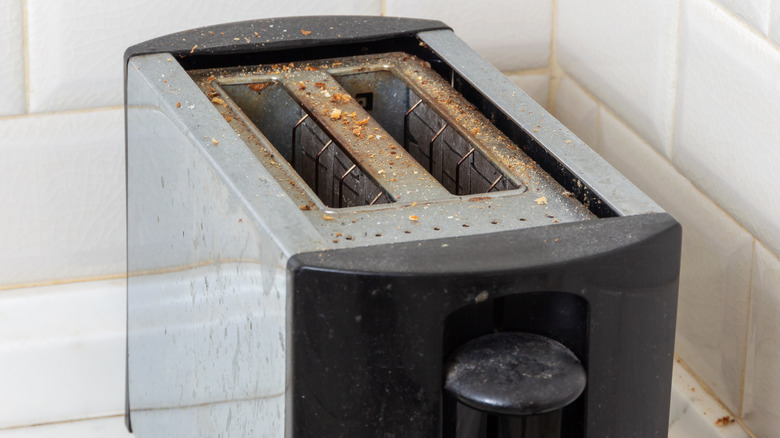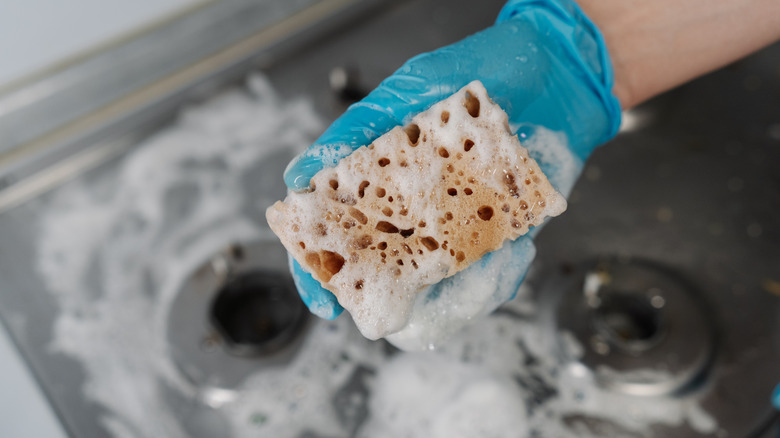Why You Need To Clean The Grease & Grime Off Of Your Kitchen Appliances (And How To Do It)
For many, cooking is largely about simply providing the sustenance needed to survive. For others, cooking is a pure point of joy that, when undertaken with skill and care, is not unlike the creation of art that you can eat. Whatever side of that divide you reside on, we'd be comfortable enough claiming that no one actually enjoys the task of tidying up a dirty kitchen, even if there are handy gadgets that can make the job easier.
Despite that fact, it is important that you do a thorough kitchen cleaning after every cooking session, if only because that's the best way to ensure your kitchen is not regularly invaded by unwanted pests. For the record, a thorough cleaning is also the best way to keep your appliances looking their best between meals and functioning properly when it's time to cook. Yes, it can also help to prevent the spread of germs and food-borne bacteria. But even apart from those factors, there are other dangers to consider in your cleaning regimen, and that's the prevention of kitchen fires.
In regard to that latter aspect, the buildup of grease and grime on stovetops and appliances located near the cooking top, as well as inside the oven itself, can be particularly problematic. In the right circumstances, that greasy buildup could even cause a dangerous kitchen fire. Here are a few tips on keeping your kitchen appliances free of grease and grime.
Cleaning smaller appliances
Even as frustrating as it can be to keep a kitchen clean, if you properly tidy up on the regular, maintaining clean appliances can be a relatively painless task. In fact, many must have kitchen appliances like coffee makers, food processors, microwaves, and toasters can be cleaned after use with little more than a damp cloth or a soapy sponge. If any of those devices are kept in the general vicinity of the stove top, regularly treating the exteriors with even those light cleaning methods can prevent the buildup of grease and grime.
However, for certain appliances like a toaster or microwave, there are other elements to consider. In the case of the former, the crumb plate should also be removed and emptied with some regularity. And in the case of the latter appliance, the turntable inside will benefit from being removed for cleaning. Likewise, heating a bowl full of water in a microwave will significantly help loosen any food or liquids that may have dried to interior surfaces, making them easier to clean.
Apart from those easy-to-maintain appliances, the cleaning of certain kitchen items might benefit from a professional touch. That includes the exhaust system over your stove, which can not only be a fire hazard, but also have a negative impact on the air quality in your home. While this task can be performed by non-professionals, a pro cleaning at least once a year may be the preferable option.
Cleaning stove tops and ovens
Now let's look at stove tops and ovens, which tend to take a little more effort to clean. Here's how to clean the grease and grime away on each.
Stove Top:
- Remove the burner grates and soak them in warm, soapy water.
- For gas stoves, do the same with the burner caps.
- With electric devices, disconnect the burner coils and hand-clean them, being sure to avoid electrical components.
- Wipe visible food from the stove top with a damp rag.
- Using dish soap and water, or a one-to-one mix of water and vinegar, wipe built-up grease away using a sponge.
- Replace all items when the stove top is clean and dry.
Oven:
Most ovens now come equipped with easy-to-use self-cleaning features. Consult your device's owner's manual to determine how to use its self-cleaning feature. If that doesn't work, oven cleaning chemicals may also do the trick, so long as you follow the instructions for use exactly as they're laid out on the product's label. For more serious buildup in the oven, a compound of baking soda and water might be needed. Here's how to clean an oven that way.
- In a small bowl, mix a 1/2 cup of baking soda with enough water to form a spreadable paste.
- Spread the paste over trouble areas with heavy grease build-up on the oven's interior.
- Allow the compound to set overnight.
- Wipe away the buildup using a clean, damp cloth.
- Use white vinegar to wipe away any remaining buildup.
Pro tip — you can also use this baking soda method to clean dirty headlights on your car.


